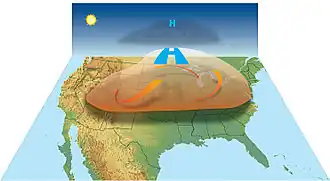
A heat dome is caused when atmosphere traps hot ocean air, as if bounded by a lid or cap. Heat domes happen when strong high pressure atmospheric conditions remain stationary for an unusual amount of time, preventing convection and precipitation and keeping hot air "trapped" within a region. This can be caused by multiple factors, including sea surface temperature anomalies and the influence of a La Niña.[1][2] The upper air weather patterns are slow to move, referred to by meteorologists as an Omega block.[3]
Creation of heat domes
In still, dry summer conditions, a mass of warm air builds up. The high pressure from the Earth's atmosphere pushes the warm air down. The air is compressed, and as its net heat is now in a smaller volume, so it must get hotter. As the warm air attempts to rise, the high pressure above it forces it down, to get hotter, and its pressure grows higher.[4]
The high pressure acts as a dome, causing everything below it to get hotter and hotter.[5] The term is often extrapolated in the media terminology for any heat wave situation. The term heat dome is also used in the context of urban heat islands.[6]
Examples

In chronological order,
See also
References
- ↑ "What is a heat dome?". National Oceanic and Atmospheric Administration. June 30, 2021.
- ↑ Burga, Sulcyre (27 July 2023). "What to Know About Heat Domes—And How Long They Last". Time.
- ↑ Freedman, Andrew (July 25, 2019). "A Giant 'Heat Dome' Over Europe Is Smashing Temperature Records, And It's on The Move".
- ↑ Rosenthal, Zachary (July 1, 2021). "Extreme heat". AccuWeather.
- ↑ Fleming, Sean (June 29, 2021). "What is the North American heat dome and how dangerous is it?".
- ↑ Lacroux, Margaux. "Qu'est-ce que le «dôme de chaleur» qui fait suffoquer le Canada ?". Libération (in French). Retrieved 2022-11-08.